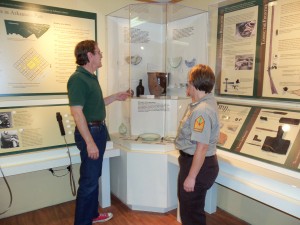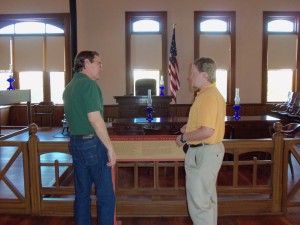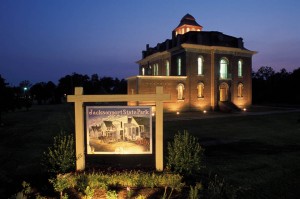Many of the Arkansas State Parks include museums that chronicle and celebrate the rich and varied history of the region. Five of those museums are located in the Ozark Gateway Region at Mammoth Spring, Davidsonville, Powhatan Courthouse, Jacksonport, and the Ozark Folk Center state parks. Each captures the spirit of the region with exhibits, activities and entertainment for the entire family, and annual events and celebrations.
Mammoth Spring State Park
Step back in time when you enter the restored 1886 Frisco Train Depot as it was at the turn of the 1900’s. Fourteen life-sized human figures portray travelers, station hands, and train crew. Two short videos tell the story of the booming city of Mammoth Spring, a manufacturing center in the late 1800’s, linked by rail and wagon roads to cities and raw materials. The museum’s baggage room includes exhibits of railroad artifacts. A Frisco caboose parked just outside is also open for touring. Welcome Center manager Adam Davis calls the Frisco Depot “a window to the past for those who didn’t experience it firsthand.” In addition to the depot, exhibits are on display in the Welcome Center and at the dam and power plant.
Mammoth Spring, properly named, is the 10th largest spring in the world. The first mill was built in 1836, driven by the nine million gallons of water that gushed from the spring per hour. In 1888 the Mammoth Spring Water Power Company built a 225-foot-long dam to bring electricity to the area long before other Ozark communities. The dam created Spring Lake and the stunning 15-foot waterfall. The park is on U.S. Highway 63 in Mammoth Spring. The museum is open Tuesday through Sunday and on Holiday Mondays except Christmas and New Years Day from 8:00 a.m. until 5:00 p.m. Admission is $2.35 for adults and $1.25 for children age 6 to 12. Group rates are available with advance notice. For information call 870-625-7364, email mammothspring@arkansas.com, or visit www.arkansasstateparks.com/mammothsprings/ .
Davidsonville State Park
Davidsonville State Park, formerly known as Old Davidsonville State Park, preserves and celebrates the history of Davidsonville, a frontier settlement that served as a regional trading center in the early 1800’s. Historical records document the steady flow of goods from Europe, New England, and New Orleans. A ferry that crossed the Black River connected to a road to Memphis that helped the town thrive. It became the first county seat of Lawrence County and boasted a two story courthouse in the town square. In 1817 it became one of two U.S. mail centers in the Arkansas portion of the Missouri Territory. Some say that an epidemic, perhaps cholera, decimated the population and led to abandonment of the town. Economic factors were probably the true cause, however. The rivers, which contributed to the importance of the town, also led to its decline. The area was prone to flooding, isolating the area for much of the time. The rerouting of the Southwest Trail, the major road through the area, away from the town, as well as the growth of nearby Pocahontas and Batesville, the latter some fifty miles to the south, contributed to the decline. In 1829, the county seat was moved approximately fifteen miles to the west to the new town of Jackson. About the same time, the U.S. land office was moved to Batesville. Having lost its governmental importance, the town slowly died. Today little is left of Davidsonville, but visitors can walk the trail through the town site and see the exhibits in the visitor’s center. The park is located at 7953 Highway 166 South. For information call 870-892-4708, email davidsonville@arkansas.com, or visit www.arkansasstateparks.com/olddavidsonville/.
Powhatan Courthouse State Park
In the 1800s, this busy river port on the Black River was the chief shipping point for a large territory. In1888, an Italianate courthouse was built atop a hill overlooking the busy riverfront from bricks made on site. This courthouse is the park’s dominant feature. Explore exhibits that interpret the commerce, politics, and lifestyles that shaped north Arkansas and illustrate the history of Lawrence County, the mother of north Arkansas counties, from its beginning to the early years of the 20th century. Take a guided tour through five buildings that share the stories of domestic and commercial life here in the 1800s. In addition to the Powhatan Courthouse, be sure to visit the Powhatan Jail, Ficklin-Imboden Log House, Commercial Building, and Powhatan Male and Female Academy, a two-room schoolhouse. Nearby are the old steamboat landing and the 70-foot-high pylons of the large suspension bridge that once spanned the Black River at Powhatan. Guided tours are available. The park is on Arkansas Highway 25 in Powhatan. For information call 870-878-6794, email powhatan@arkansas.com, or visit www.arkansasstateparks.com/powhatancourthouse/ .
Jacksonport Courthouse Museum at Jacksonport State Park
When you visit Jacksonport State Park, just a few miles from Newport, you stand in a place that was a thriving river port in the 1800s. Located near the confluence of the Black and White Rivers, Jacksonport was a busy river port that welcomed steamboats from the Arkansas and Mississippi Rivers throughout the year. The town became the Jackson County Seat in 1854. In 1869, construction began on a stately, two-story brick courthouse. The structure was completed in 1872 and the town flourished; however, when bypassed by the railroad in the 1880’s, the town of Jacksonport began to decline. Curiously, it was the citizens who voted against the Iron Mountain and Southern Railroad request for a spur and depot in Jacksonport.
In 1891, the county seat was moved to nearby Newport; Jacksonport’s stores, wharves, and saloons soon vanished. Today the restored courthouse serves as a museum where exhibits themed, “If These Walls Could Talk,” incorporate first-person dialogue audio, court records, and vintage photos to tell Jacksonport’s story. The town was occupied by both Confederate and Union forces during the Civil War because of its critical location. Exhibits demonstrate the suffering of residents during that dark era. Mark Ballard, Park Superintendent, also points out that “guided tours are available that provide unique insight into the history of the area and also gives visitors a fun, educational experience.” The park is on Arkansas Highway 69 in Jacksonport. For information call 870-523-2143, email jacksonport@arkansas.com, or visit www.arkansasstateparks.com/jacksonport/.
Ozark Folk Center State Park
The Ozark Folk Center State Park in Mountain View opened in 1973 as “a home for traditional mountain music and crafts.” Over the years it has added additional elements to reinforce its mission of preserving the heritage of the Ozarks. The crafts village offers demonstrations of basketry, blacksmithing, candle making, broom and doll making, pottery, quilting, wood carving, printing, spinning, weaving, and other crafts rooted in the Ozarks. Grady Spann, Park Superintendent, appreciates the park’s unique focus, “The craft village at the Ozark Folk Center State Park is a unique experience for every visitor. Each one of the twenty-two crafters demonstrates crafts that were unique to the Ozarks at the turn of the 19th century. These are “one of a kind” creations that are not found in any department stores. They are truly Ozark crafts.” Visitors are welcome to take participate in demonstrations of weaving, pottery, blacksmithing, and other heritage crafts.
The Heritage Herb Garden and Greenhouse contain garden and medicinal plants used by mountain folk as far back as 1820; old-time pass-a-long plants such as rosemary, scented geranium, sages, mints, and coneflowers are arranged in cottage garden planting. More than a dozen distinct herb gardens showcase the entire range of medicinal and edible herbs, as well as those used for other purposes. Garden workshops are scheduled regularly on topics such as cooking with herbs, container gardening, and the culture of herbs.
The Folk Center preserves and celebrates music predating WWII. Regular concerts take advantage of the many local musicians who keep the traditional music alive; in addition, nationally-known folk groups, such as The Nitty Gritty Dirt Band, also find their way to the Mountain View. Folk dancing is treated with great respect and enthusiasm; jig, square, and clog dancing performances are common and audience members are invited to participate. The Folk Center also houses the Ozark Cultural Resource Center, an unrivaled collection of Ozark music and historical documents.
For information call 870-269-3851, email ozarkfolkcenter@arkansas.com, or visit www.ozarkfolkcenter.com. For additional information about the Ozark Gateway region, including restaurant reviews, visit www.ozarkgateway.com, call 800-264-0316, or pick up our free annual tourist guide magazine, available at stores, restaurants, hotels, gas stations, museums, state parks, and visitor centers. Watch for new articles coming soon.










